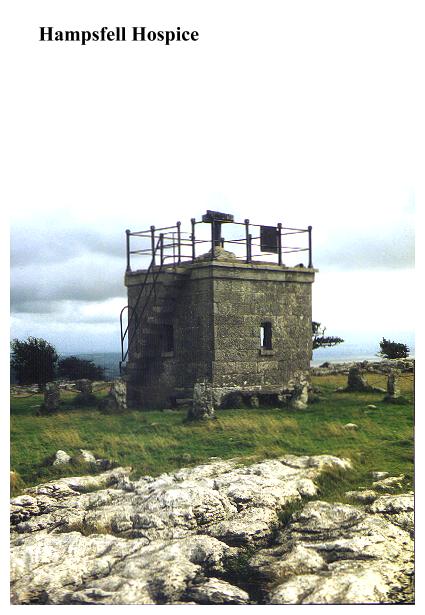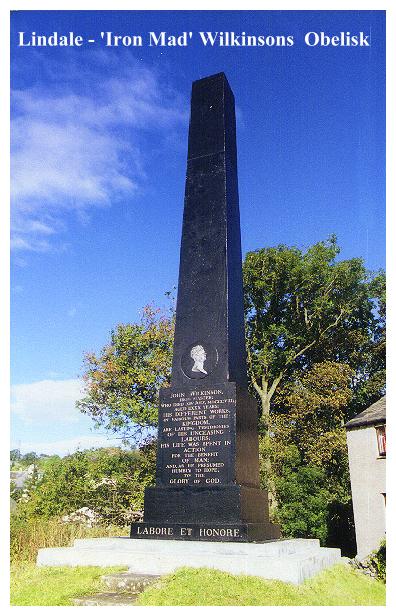14. HAMPSFELL HOSPICE AND LINDALE
England's warmest resort, fine woodlands, limestone scenery, views to the Lake District and Morecambe Bay, a curious prospect tower, and a positively bizarre cast-iron monument to an 'iron mad' industrialist, are the attractions of this excellent and very popular walk high above the sands of Morecambe Bay
Getting there: A590-B5277 to Grange Over Sands. Grange is also easily reached by rail.
Distance: 9 miles
Map ref: Grange (stn.) SD 412 782. Hampsfell Hospice SD 399 794
Rating: Walk*** Follies and General Interest**
As a seaside resort, Grange is something of a disappointment. True, it has a prom with the traditional iron railings and seats, but sandwiched as it is between the railway line and the mudflats of Morecambe bay it hardly competes with Blackpool. Grange's attractions lie more in the realms of its mild climate, ornamental lakes and gardens, fine hotels and pleasant woodland walks, the latter being particularly extensive.
Grange-Over-Sands does not lie beside Morecambe Bay, rather it perches over it. Grange's hinterland is limestone, steep and rocky, and from the centre of Grange to the summit of the fells is but a short, sweet and decidedly steep ascent through a landscape of sylvan woodlands and limestone pavements. These same fells form a perfect windbreak to the north, and contribute, along with warm air carried here under the influence of the Gulf Stream, to the exceptionally mild climate which Grange enjoys.
Grange itself was largely created by the arrival of the Ulverston and Lancaster Railway in 1857, which brought an influx of gentry to the area, attracted by the mild and charming climate. Prior to this it was little more than a few whitewashed fishermen's cottages. As this formerly isolated community began to develop into a resort it aquired the suffix '-over-Sands', along with the fine Victorian villas, hydropathic establishments, churches and convalescent homes which began to mushroom all over the area.
These were followed by the the construction of Grange's fine promenade, wildfowl pond and ornamental gardens, the gardens and rockeries themselves being cunningly designed to screen off the adjacent railway line. Grange's fine clocktower was built in 1913. It has a peculiarly Germanic character and seems somehow out of place in sedately English Grange. It stands by St Paul's Church.
Our walk starts and finishes on Windermere Road, which leads off from the main road through Grange between the railway station and the wildfowl pond. You should be able to park along Windermere Road. A short distance along the road, we turn into Eggerslack Wood and our walk begins in earnest.
Eggerslack Wood contains many paths and nature trails, and in character is very similar to the woodlands encountered over at Silverdale on the walk to the Pepperpot. This is hardly surprising, as these landscapes are only separated by the Kent Channel and geologically have much the same origins. Eggerslack Wood was originally managed for charcoal burning and the making of baskets and hurdles, but this work declined in the interwar years. The remains of coppicing, however, may still be seen in the clusters of stems growing out of single stumps. The woods consist predominently of birch, ash, sycamore oak and hazel, with a sprinkling of breech, larch and wild cherry. The flora is what you would expect in such a fine woodland, and there is much to interest the naturalist. Badgers, foxes and red squirrels occur, along with the occasional roe deer. Eggerslack Wood is a place worthy of detailed exploration.
But not today - for we are here in search of follies. After a long ascent we come out onto the open fell, an area of scrub, limestone pavements and drystone walls, and after an initially confusing tramp up the fellside we suddenly come in sight of our main objective, the squat, square prospect tower of Hampsfell Hospice.
(!INSERT HAMPSFELL HOSPICE>

Hampsfell Hospice was built by George Remington, who was Vicar of Cartmel between 1835 and 1854. It was constructed primarily as a viewing platform and shelter for wanderers over the fell. It is essentially a 'one up- one down' sort of structure, surrounded by a chain fence on stone blocks. The lower storey contains seats and a fireplace, while the flat roof, reached by precarious stone stairs up the side of the building, forms an admirable lookout platform from which to take in the extensive views ranging from Lancaster to Lakeland. The hospice stands at 727 feet above sea level, and on the roof is a marvellously ingenious and ponderous direction indicator, originally built by a retired railwayman simply for the pleasure of doing it.
The view of course is superb, taking in the Lakeland mountain skyline, the Howgill Fells, the Pennines and Ingleborough, and the Bowland Fells behind Lancaster. Clougha Pike is in view, as is the Ashton Memorial, and nearer at hand the Hoad Monument may be seen to the west, along with Walney and Piel Islands. To the east stands Arnside Knott, between Arnside and Silverdale, and southwards lies Heysham Power Station, beyond which (hopefully) we can see the top of Blackpool Tower. Immediately below us the grey Kirkhead Tower stands on its knoll behind Humphrey Head, and on exceptional days, Snowdon and the Isle of Man should be visible!
Around the walls in the room below are a series of painted boards. They are curious in the extreme and surprisingly unvandalised, though one suspects few visitors take the trouble to read them. This is sad, because more than anything else these hopelessly romantic verses give a marvellous insight into the eccentric character of the kindly clergyman who built the hospice - George Remington:
THE HOSPICE OF HAMPSFELL
THIS HOSPICE HAS AN OPEN DOOR,
ALIKE TO WELCOME RICH AND POOR;
A ROOMY SEAT FOR YOUNG AND OLD
WHERE THEY MAY SCREEN THEM FROM THE COLD
THREE WINDOWS THAT COMMAND A VIEW.
TO NORTH, TO WEST AND SOUTHWARD TOO;
A FLIGHT OF STEPS REQUIRETH CARE,
THE ROOF WILL HOW A PROSPECT RARE:
MOUNTAIN AND VALE YOU THENCE SURVEY,
THE WINDING STREAMS AND NOBLE BAY:
THE SUN AT NOON THE SHADOW HIDES,
ALONG THE EAST AND WESTERN SIDES.
A LENGTHENED CHAIN HOLDS GUARD ROUND,
TO KEEP THE CATTLE FROM THE GROUND;
KIND READER FREELY TAKE YOUR PLEASURE,
BUT DO NO MISCHIEF TO MY TREASURE:
THE ANSWER
AND IF THE RICH AND POOR SHOULD MEET
I TRUST THEY WILL EACH OTHER GREET,
AND RICH AND POOR AND YOUNG AND OLD
TOGETHER SCREEN THEM FROM THE COLD:
AND AS THE WINDOWS ARE NOT GLASS'D
WE'LL MIND TO LEAVE THE SHUTTERS FAST,
THE "FLIGHT OF STEPS REQUIRETH CARE"
THEN WHY NOT HAVE A HANDRAIL THERE;
THAT FEEBLE OLD AND TIMID FAIR
MAY MOUNT AND VIEW THE PROSPECT RARE:
THE BLUE AND LOFTY MOUNTAIN'S SIDES
THE NOBLE BAY AND STEALTHY TIDES,
THAT TREACHEROUS CREEP ALONG THE SAND
OR LOUDLY DASH UPON THE STRAND:
YON GAILY RIGGED TRIM PLEASURE BOAT
UPON THE GLITTERING WAVES AFLOAT,
THEN (TURNING TO THE WEST) IS SEEN
DEAR CARTMEL'S PEACEFUL VALLEY GREEN;
MID WANING WOODS AND VERDANT LANDS;
THE FINE OLD CHURCH OF CARTMEL STANDS;
WITHIN WHOSE WALLS IN DAYS OF YORE
HIS PRIESTLY RULE THE PRIOR BORE;
THEN MAY THE LENGTHENED CHAIN AROUND
KEEP ONLY CATTLE FROM THE GROUND!
FOR NO GOOD MAN WOULD THINK IT PLEASURE
TO CLIMB THE FELL TO SPOIL YOUR TREASURE
YOUR OFFER MADE IN KINDLY SPIRIT
I HOPE YOU'LL FIND OUR CONDUCT MERIT:
CARTMEL 1846
A further notice warns against vandalism:
TAKE NOTICE
ALL PERSONS VISITING THIS "HOSPICE" BY PERMISSION
OF THE OWNER ARE REQUESTED TO RESPECT PRIVATE
PROPERTY, AND NOT BY ACTS OF WANTON MISCHIEF
AND DESTRUCTION SHOW THAT THEY POSSESS MORE
MUSCLE THAN BRAIN. I HAVE NO HOPE HAT THIS
REQUEST WILL BE ATTENDED TO, FOR AS SOLOMON SAYS
"THOUGH THOU SHOULDST BRAY A FOOL IN A MORTAR AMONGST
WHEAT WITH A PESTLE YET WILL NOT HIS FOOLISHNESS
DEPART FROM HIM"
G. REMINGTON
Outside the Hospice there is a curious inscription in Greek over the door lintel.
Before leaving the Hospice, a large cairn nearby is worthy of note. This marks the site of an ancient burial, and according to local tradition contains the bones of soldiers who fell in AD 96 in a battle between Dunmail, King of Cumbria, and Edmund, King of the invading Saxons. In more recent times, the men of Cartmel gathered here in November 1745 to repel Jacobite rebels who were believed to be in the district.
From Hampsfell Hospice round to Lindale our route is scenic in the extreme, with marvellous sweeping views, particularly of the Lake District. There is also much of interest to the botanist, the limestone clints containing exotic ferns, and the grasslands being richly carpeted with eyebright, tormentil and wild thyme. On the limestone grow gorse and juniper bushes. This kind of scrub-land is known locally as 'savin'. After following a gully down to a gate and continuing onwards through conifers we descend a while towards the road, but before reaching it double back sharply right, crossing fields to an old limekiln in an excellent state of preservation. Beyond a track leads round to Stonegarth, passing a postbox and an interesting covered well en route.
At Stonegarth a choice must be made. Beyond, our route descends steeply down to Lindale, but having visited Lindale you will have to retrace your steps to this point. A right turn however, takes us back to Eggerslack Woods and back down to Grange by a different route. The main attraction of Lindale, the Wilkinson Obelisk, stands beside the main road to Grange, and can be easily inspected by car. If the day is late, or you are tired, you would be wise to follow the latter option.
Lindale is a pleasant little village straggling a steep fellside. It has a pleasant little church, built by George Webster of Kendal who is buried in the churchyard in an elaborate grave. Mrs Gaskell lived here for a while while writing The Sexton's Hero, but Lindale is best known for its association with one of the founding fathers of the Industrial Revolution- John 'Iron Mad' Wilkinson.
John Wilkinson was a powerful and extraordinary figure. Devious and rough- spoken, he was possessed of a foul temper and a political radicalism which did not endear him to his contemporaries. Wilkinson originated from the Penrith area, but at the age of twelve, in 1741, his family moved to nearby Backbarrow. At the age of 19 he purchased a furnace and forge at Wilson House, which lies near the present main road between Lindale and Levens Bridge. Here he invented the box iron, using an old mill in Lindale for processing his materials. Wilkinson built his own canal alongside the Winster, and built the world's first iron boat to carry peat and brick clay along it. People laughed at his 'iron boat', being confident it would sink, but Wilkinson proved them wrong!!
His fame and influence soon stretched far beyond sleepy Lindale, and most of Wilkinson's work took place in fact in the Midlands, to which he moved as a young man, his chiefest monument being the famous iron bridge over the Severn at Coalbrookdale, Shropshire. There can be no doubt that the genius of this wayward and eccentric man lay behind many of the innovations which made possible the Age of Steam.
When Wilkinson retired, he returned to Lindale and built himself a great Georgian mansion at nearby Castle Head with the proceeds of his industrial successes. This was an area of barren rock which Wilkinson domesticated into a garden paradise - an estate surrounded by a high, castellated wall. He originally employed local folk to work on this project, but as they would not work on Sundays he brought in large numbers of Irish navvies, whom he summoned with an ancient bell he had acquired from Cartmel Priory.
On his death in 1801, Wilkinson willed that his body be buried in an iron coffin which he had long kept for the purpose. He was laid to rest in his own garden at Castle Head, his grave being topped by the massive iron Obelisk we now see in Lindale. Later tenants of Castle Head objected to having John Wilkinson at the bottom of their garden, and he was eventually exhumed and re-interred in the churchyard at Lindale. Not surprisingly the people of Lindale did not want Wilkinson's massive iron monument gracing their tiny churchyard, so iron master and iron obelisk were parted, the Obelisk remaining at Castlehead at a safe distance from hallowed ground.
But this was not the end of the Wilkinson saga, for the Obelisk was not fated to remain at Castle Head. In June 1983 it was moved from there and erected at its present position. In 1984 the parish council commissioned Dorothea Restoration Engineers Ltd of Buxton to restore the Obelisk, the cost being met by various grants and a nationwide appeal.
They did a good job. Today, Wilkinson's black iron monument gleams in its little triangular garden alongside the B5277 and Dixon Wood Close. On the side of the monument is a profile relief of Wilkinson himself, with the following inscription:
JOHN WILKINSON
IRON MASTER
WHO DIED XIV JULY,MDCCCVIIII
AGED LXXX YEARS
HIS DIFFERENT WORKS
IN VARIOUS PARTS OF THE
KINGDOM
ARE LASTING TESTIMONIES
OF HIS UNCEASING
LABOURS
HIS LIFE WAS SPENT IN
ACTION
FOR THE BENEFIT
OF MAN
AND, AS HE PRESUMED
HUMBLY TO HOPE
TO THE
GLORY OF GOD
LABORE ET HONORE.
Yet a part of the inscription is missing. If you look very carefully above the name of 'John Wilkinson', you should just be able to make out the shapes of two words which have been carefully effaced from the Obelisk- they are:-
HERE LIES
John Wilkinson and his Obelisk are still parted.
So we come to the end of our journey. If you have not driven to Lindale, it is now time to retrace your steps back up to Stone Garth. As you ascend the hillside from Lindale, look out for the Eller How Tower, a sham ruin that stands atop Ravensbarrow Crag opposite. Back on Hampsfell, we follow a path along the top of Eggerslack Woods, before descending this delightful woodland once more by a different path, which, nevertheless, leads us eventually back to Grange. As with most of the walks on this side of Morecambe Bay, you are left with the feeling that there is much more to see than you actually saw, and the urge will be to return once again and explore further. Yet no matter how many times you return here, 'oversands' Lancashire is an area that will always invite further exploration.









